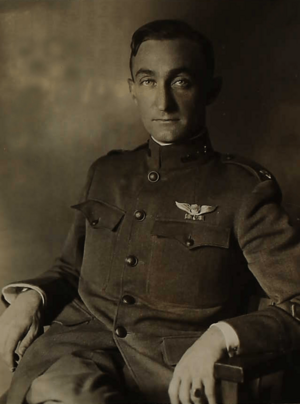Harold Geiger facts for kids
Quick facts for kids
Harold Geiger
|
|
|---|---|

Geiger in 1911
|
|
| Born | October 7, 1884 |
| Died | May 17, 1927 (aged 42) Olmsted Field
Harrisburg, Pennsylvania, US |
| Cause of death | Aircrash |
| Resting place | Arlington National Cemetery |
| Education | United States Military Academy (1904–1908) |
| Spouse(s) | Frances M. Bridges |
| Children | 2 |
Harold Geiger (born October 7, 1884 – died May 17, 1927) was an early American military pilot and balloon expert. He was actually the sixth person to become a US military aviator! Sadly, he died in an airplane crash in 1927. Today, Spokane International Airport uses the code GEG to remember him.
Contents
Early Life and Military Career
Harold Geiger was born in East Orange, New Jersey, on October 7, 1884. He went to East Orange High School. Later, he joined the United States Military Academy at West Point in 1904. He graduated in 1908 as a second lieutenant in the Coast Artillery Corps of the Army.
He was promoted to first lieutenant in November 1908.
Flying in Hawaii
As a lieutenant, Geiger was put in charge of the Army's aviation (flying) equipment in the Hawaiian Islands. The first Army airplanes and pilots arrived in Oahu in July 1913. These planes were based at Fort Kamehameha, which is near where Hickam Air Force Base is today.
Lieutenant Geiger arrived in Oahu with two Curtiss Aeroplane Company seaplanes. He also had a mechanic, 12 soldiers, and other gear. However, Geiger's airplanes were not in good condition. He could only make short flights in Pearl Harbor. He also made one longer flight to Diamond Head, Hawaii, and back to Fort Kamehameha.
Geiger was told to stop all flying in late 1913. This was because the strong trade winds made flying too dangerous. The airplanes were sold there, and their engines were sent back to the North Island Flying School. The Army did not have any more airplanes in Hawaii until 1917.
Balloons and Dirigibles
Geiger also became an expert in balloons. He finished courses at the U.S. Army Balloon School in April 1917. During World War I, he worked overseas with the Army's Balloon Section Headquarters in France. He was a lieutenant colonel at that time.
He also studied dirigibles (large airships) in France and Italy. Later, he worked with the Ambassador's staff in Berlin, Germany. While in Germany, Major Geiger sent reports to the Chief of the United States Army Air Service. He wrote about the building of the dirigible USS Los Angeles. He strongly suggested that the Army should buy this airship. The Navy later took over the Los Angeles. Geiger was even on the Los Angeles when it flew across the Atlantic Ocean!
Geiger also commanded the Army Balloon School at Ross Field in Arcadia, California. By 1927, Geiger was the leader of Phillips Air Field in Aberdeen, Maryland.
A Mid-Air Collision
On May 10, 1926, Major Geiger was slightly hurt in a mid-air crash. This happened between two airplanes at Langley Field, near Hampton, Virginia. He was attending the Air Corps Tactical School there. His airplane and another plane, flown by fellow student Horace Meek Hickam, hit each other and crashed.
His Final Flight
On May 17, 1927, Geiger died in an airplane crash. He was flying an Airco DH.4 and was taking off for a flight to Aberdeen Proving Grounds, Maryland. A newspaper reported that six mechanics and officers at the Middleton Air Station saw the crash. They said Geiger's airplane dove into the ground from about 50 feet (15 meters) up.
Geiger managed to jump out just as the airplane hit the ground and caught fire. He tried very hard to get away from the burning plane. Witnesses said he half-crawled and ran as far as the tail of the machine. But then he was overcome by the flames. The fire stopped anyone from getting close enough to rescue him. Major Geiger was buried at Arlington National Cemetery.
Legacy and Airport Naming
In 1941, the United States Department of Defense bought an area known as Sunset Field. This was to be a training place for pilots during World War II. Pilots would learn to fly planes like the Boeing B-17 Flying Fortress and the Douglas C-47 Skytrain. After buying it, they renamed the facility Geiger Field. This was done to honor Major Harold Geiger.
In 1946, part of the airfield became a public airport. Commercial airline flights moved there from Felts Field. In 1960, the airport was renamed Spokane International Airport. However, its airport code is still GEG, in honor of Geiger.
Images for kids



